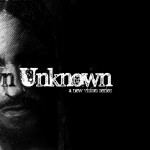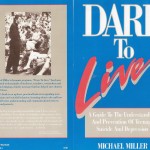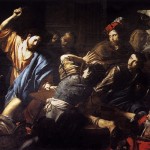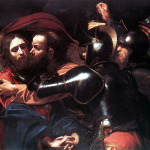There are four things I think people find particularly puzzling about Mark’s gospel.
- Jesus partial healing of a blind man. Why does Jesus heal twice?
- The young man who runs away naked in Mark 14. He’s not found in any other gospel. Who is this man?
- The ending of Mark at 16:8. The women are told that Jesus is alive and instructed to tell the disciples. But instead they run away and say nothing. Is this a fitting ending to the Good News?
- The resurrection meeting in Galilee. Why doesn’t Mark just say Jesus will meet them in Jerusalem like Luke?
The answers to these questions are important for understanding Mark’s message.
 The Call to Follow
The Call to Follow
Jesus calls men to follow. “Follow me,” he says to Peter and Andrew. They leave everything to “follow him.” (1:16-18). He likewise calls James and John and Levi the tax collector and they too leave everything (1:19-20; 2:14) All together he chooses twelve men so that “they might be with him…” (3:14). The Apostles are called to follow him wherever he goes. They are to do what he does.
But the disciples, those near him, don’t have a clue who he is. Over and over again Jesus finds them totally lacking in intelligence.
They are perplexed when Jesus instructs them to feed the five thousand. But when he shows them how to do it they can’t remember what to do two chapters later he asks them to feed the four thousand.
Jesus has given them the key to parables (Mark 4:10-13). But Jesus teaches plainly in Mark 7:14-15, the disciples turn around and ask for an interpretation of the parable (7:17-23). ITS NOT A PARABLE!
And after Jesus has already feed the multitudes twice, Mark tells us that he once again he found them concerned about bread (8:14-16). Jesus’ patience wears thin.
Why are you talking about having no bread? Do you still not see or understand? Are your hearts hardened? Do you have eyes but fail to see and ears but fail to hear? And don’t you remember?… Do you still not understand?”
They don’t know how to follow Jesus.
We cringe at such depictions of the disciples. We cringe because we can relate. But that’s precisely why Mark holds them up to this harsh light. He wants us to see ourselves in this bumbling group of men.
But something breaks in chapter eight. While in the far north, Jesus asks his disciples the question everyone’s been dieing to know, “who do you say that I am.” Peter answers, “You are the Christ.” For the first time he lets them in on his ultimate plan
the Son of Man must suffer many things and be rejected by the elders, chief priests and teachers of the law, and that he must be killed and after three days rise again. (8:31)
But its too much for Peter. Stupid returns. He rebukes Jesus! Jesus, however, rebukes Peter and gathering his disciples he teaches them what it means to follow him.
If anyone wishes to come after Me, he must deny himself and take up his cross and follow Me. For whoever wishes to save his life will lose it, but whoever loses his life for my sake and the gospels will save it.
To follow Jesus means to die with him.
Mark structures Jesus journey to Jerusalem around three misunderstandings. The second two found in Mark 9:30-35 and 10:32-45, follow the pattern established in Peter and Jesus’ exchange. In each Jesus begins by teaching on his death in Jerusalem. The disciples, however, are found to act in ways contrary to this reality. This will lead Jesus to again teach them what it truly means to follow Him.
Question 1: The Blind Man’s Partial Healing
Jesus journey to Jerusalem and three misunderstandings are bookend by the healing of two blind men. Jesus’ two part healing is the first (8:22-25). Without a doubt this healing is a symbol of Peter and the disciples partial sight. It occurs just after Jesus calls the disciples blind (8:17) and immediately before the exchange with Peter. Though disciples see Jesus as the Christ they have yet to see all that this entails. The healing of Bartimaeus (10:45-52) occurs immediately after the last of three misunderstandings. His healing leads him to “follow Jesus along the road.”
But sadly the disciples never get it. When they finally arrive in Jerusalem, they show themselves to be tragically and traitorously inept. Judas, one of the twelve, goes to the leaders and offers to betray Jesus. When Jesus predicts this, Peter and the other disciples respond with oaths of loyalty. But in Gethsemane, Mark states that at the sight of the soldiers, “they all left him and fled.”
At the sight of the soldiers, the disciples abandon their call. At the first sign of danger, they all run away. Jesus has called them to follow him to his death. He has called them to suffer. The disciples choose life instead.
It is here in this moment that we find the young man running away naked, leaving his linen sheet behind. Who is this man and why does he appear here? There are some interesting clues. First, a linen sheet only appears one other time in the gospel of Mark and its wrapped around the dead body of Jesus. Secondly, nakedness, after the fall, is always a sign of shame. For these reasons as well as one other that I will reveal in a moment I believe Mark uses this young man as a symbol for the very failure of the disciples. They have been called to follow Jesus to his death but in this moment they all run away in shame leaving the death that Christ has clothed them in behind.
Shocking! The disciples, the very twelve apostles, when confronted with the death that Christ demands turn around and flee. But they are our fathers, they are our representatives. And like them we Fat Christians have abandoned Christ’s call. I’m sure each of us can remember the sweetness of our conversion when Christ first called us to follow. Like the disciples we left everything. Like their time in Galilee, the beginning was trouble-free. It was easy to follow because everything was so sweet. But as the years passed life seemed to seep back in. We got married, had some kids, bought a house in which live. Now there were mortgages to pay, vacations to plan, and cars to fix and repair. We sought people and places that would affirm us. We’ve looked for glory in the eyes of others. Suffering for Christ became the last thing on our minds. And now it’s not a question whether we would follow him to his death for we ceased to follow all ready. Like the disciples we’ve already denied him. We’ve already turned and walked away. Examined in light of Christ’s own example we find ourselves totally lacking. Can we do what Jesus did? Can we walk the road he himself has blazed?
That’s the powerful question in Mark’s disturbing ending. Mark tells us that the women who go to the tomb on Sunday Morning are met by a young man clothed in white. Notice how Mark alone among the gospels doesn’t call this figure an angel. Instead he calls him a “young man.” It’s the same description used for the streaking disciple, the young man that runs away in the Gethsemane, leaving the linen sheet behind. Well, now he’s clothed in white and he has a message for the disciples. “’He is going before you into Galilee; there you will see Him, just as He said to you.” But again in the very next verse the women, like the disciples before, run away and say nothing for they themselves are afraid. The end? Yup, that’s it.
All the questions you had about the disciples, Mark doesn’t answer. Did they go to Galilee? Did they meet Jesus again? He doesn’t say. Why not? Why doesn’t he say? Answer: Because he leaves it to you. Without denying the difficulty, Jesus extends his forgiveness in reestablishing the call. He goes before you. Will you follow? The answer and the end is up to you.















